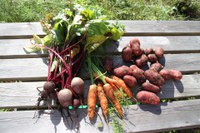Prairie Fare: Consider Composting
(Click an image below to view a high-resolution image that can be downloaded)
By Julie Garden-Robinson, Food and Nutrition Specialist
NDSU Extension
“You’re moving the compost pile?” I asked.
I had a note of disbelief in my voice.
“Well, yeah,” my husband replied matter-of-factly.
End of conversation.
About 15 years ago, we moved from our first house to our current one, along with our compost pile and three young kids.
My husband found a nice, shady spot cleverly hidden under some evergreen trees.
I think the real estate agent was happy we moved the compost pile prior to trying to sell our original house.
Composting has been my husband’s pet project. He moved from Oregon, where recycling and composting were regular habits, to North Dakota many years ago.
After 27 years of marriage, I have adapted to having a lot of bins for recycling and composting.
My husband has adapted to my love of growing flowers, vegetables and fruit trees.
Actually, our hobbies are mutually beneficial. My garden scraps feed the compost pile. The compost helps my gardens grow really well.
Composting also is good for the environment. According to a University of Washington study, food waste generates methane when it goes to landfills but not when it is composted. When you compost at home, you are doing a favor for the environment.
Some people call compost “black gold” because this rich mixture of decomposed plant material provides nitrogen, copper, zinc, phosphorus and other nutrients.
If you never have composted, you might want to consider it. About 95% of food scraps end up in the landfill. Composting is a way to reduce food waste while transforming plant materials into rich, fertile humus through the action of microorganisms.
Find a shady spot because your compost pile should remain moist and not dry out. Many experts suggest starting with a bin that is 3 by 3 by 3 feet or a 5-foot cube. You can buy a bin or make your own. You will need a shovel or pitch fork to turn your pile.
Think of compost as a mixture of greens, browns and water. In general, a 50:50 mixture of greens and browns is the recommended “recipe.”
“Greens” include items such as apple cores, leafy greens, onion skins, corn cobs and husks, egg shells, banana peels, potato peels, weeds and coffee grounds. Most of these items are particularly high in nitrogen.
“Browns” provide carbon and include small branches, leaves, shredded paper, nut shells, coffee filters, straw, wood chips and empty cardboard tubes.
Smaller pieces will break down more quickly.
Water also is essential for the microorganisms to act. The pile should be damp, like a wrung-out sponge.
Avoid putting certain items in your compost bin. Fats, grease, oils, meat and bones may attract unwanted animals to your bin and cause odor. If you have pets, do not put their waste in the bin. Avoid adding yard trimmings treated with pesticides, diseased plants or weeds with mature seed heads.
Composting does require some tending. Experts suggest turning it monthly or more often. On average, with the right conditions, you will have compost ready in about three months.
You can keep feeding your compost bin in all seasons. Although turning the compost may become impossible in the winter, the breakdown of the plant material will continue slowly.
We have added our compost to raised gardens or put it around trees and shrubs to hold moisture.
Our compost is placed in garbage cans on wheels so we can move it easily around our yard. Try placing about 3 inches of compost on top of soil and working it 8 to 12 inches into the soil.
Did I mention I like flowers? I have many containers around our yard that show their appreciation for the natural fertilizer by blooming brightly. Most gardening experts recommend about one part compost to three parts soil for potted plants.
As food preservation season continues and fall yardwork begins, I will share plenty of scraps and yard waste with the compost bin.
This recipe provides a delicious side dish for dinner and peelings for a compost bin. Add a meatloaf or other protein to these roasted root vegetables and you have an oven dinner perfect for a fall evening.
Roasted Root Vegetables
4 medium-sized vegetables (potatoes, sweet potatoes, turnips, beets)
2 carrots, pared and chopped
1 medium onion, chopped
3 Tbsp. cooking oil (such as olive, canola, sunflower)
Spices of choice (Italian seasoning, rosemary, pepper, etc.)
Preheat oven to 350 F. Rinse, peel and cut vegetables into chunks. Place in a bowl and add oil. Add seasoning and mix well. Spread in a single layer on a baking sheet with sides. Bake about one hour, until vegetables are tender.
Makes four servings. With two potatoes, a sweet potato and a beet, and Italian seasoning, each serving has 190 calories, 10 grams (g) fat, 3 g protein, 26 g carbohydrate, 4 g fiber and 30 milligrams sodium (without added salt).
(Julie Garden-Robinson, Ph.D., R.D., L.R.D., is a North Dakota State University Extension food and nutrition specialist and professor in the Department of Health, Nutrition and Exercise Sciences. Follow her on Twitter @jgardenrobinson)
NDSU Agriculture Communication - Sept. 10, 2020
Source: Julie Garden-Robinson, 701-231-7187, julie.garden-robinson@ndsu.edu
Editor: Ellen Crawford, 701-231-5391, ellen.crawford@ndsu.edu




